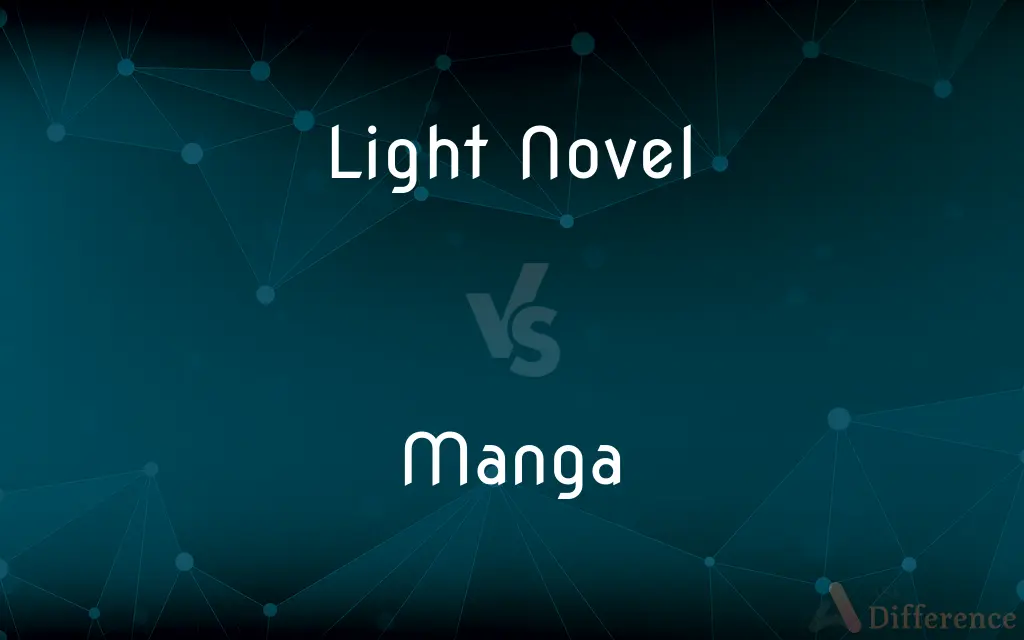Light Novel vs. Manga — What's the Difference?
By Tayyaba Rehman — Published on October 22, 2023
A Light Novel is a style of Japanese novel primarily targeting high school and middle school students, which is illustrated and uses a manga style; Manga is a style of Japanese comic books and graphic novels, primarily read in a right-to-left format.

Difference Between Light Novel and Manga
Table of Contents
ADVERTISEMENT
Key Differences
Light Novels and Manga are both crucial elements of Japanese pop culture but serve different creative expressions. A Light Novel is a type of Japanese young adult novel that combines text with manga-style illustrations, aimed typically at high school and middle school students. These novels often explore themes of fantasy, science fiction, or romance and are written in a relatively easy, conversational style to be accessible to younger readers. They usually have anime-style cover art and are often adapted into anime and manga.
Manga, in contrast, is a Japanese comic book or graphic novel, created for all age groups, involving various themes and genres. Unlike Light Novels, Manga is more visual and primarily consists of images, with dialogues and thoughts represented in speech bubbles, and is usually read from right to left. They have a broad audience and are a significant aspect of Japanese culture, often adapted into anime, movies, or series.
While Light Novels contain illustrative content, they are more textual and narrative-driven, allowing for detailed character development and plot exploration. They offer readers a comprehensive experience of the story, enabling them to delve deep into the characters' thoughts, emotions, and motivations. Light Novels provide a rich, immersive reading experience, allowing readers to engage with the story on a deeper level.
On the other hand, Manga relies heavily on visual storytelling, utilizing detailed illustrations, expressive characters, and dynamic panel arrangements to convey the story, emotion, and action. This form of storytelling emphasizes visual elements and expressions, giving readers immediate access to characters’ emotions and actions, making the story vivid and engaging.
In summary, while Light Novels are illustrated novels predominantly focusing on narrative and text to convey stories to a younger audience, Manga is a diverse and rich medium of storytelling primarily through visual artwork, catering to a wide range of audiences and covering various genres and themes.
ADVERTISEMENT
Comparison Chart
Primary Element
Text with illustrations
Images with dialogues in speech bubbles
Target Audience
High school and middle school students
All age groups
Format
Illustrated novel
Comic book or graphic novel
Focus
Narrative and character development
Visual storytelling and expressions
Adaptations
Often adapted into anime and manga
Often adapted into anime, movies, or series
Compare with Definitions
Light Novel
Primarily textual but incorporates manga-style illustrations to complement the narrative.
The Light Novel uses illustrations strategically to enhance the understanding and appeal of the story.
Manga
Caters to a broad audience and covers a variety of genres and themes.
From action to romance, Manga offers a diverse range of genres for readers of all preferences.
Light Novel
Often adapted into anime and manga.
Fans were thrilled when the popular Light Novel was announced to be adapted into an anime series.
Manga
Primarily consists of images with dialogues and thoughts in speech bubbles.
The Manga effectively conveyed characters' emotions and dialogues through expressive speech bubbles.
Light Novel
A Japanese novel style, usually illustrated and targeting younger readers.
The Light Novel explores complex themes in a narrative, accessible style, accompanied by illustrations.
Manga
A Japanese style of comic books or graphic novels, read from right to left.
The Manga depicted the story vividly through its detailed and dynamic illustrations.
Light Novel
Often features anime-style cover art and is typically written in a conversational style.
The expressive cover art of the Light Novel immediately caught my eye at the bookstore.
Manga
Often adapted into anime, movies, or series.
The widespread popularity of the Manga led to its successful adaptation into an anime series.
Light Novel
Typically explores themes of fantasy, science fiction, or romance.
The Light Novel captivated readers with its unique blend of fantasy elements and romantic subplots.
Manga
Utilizes visual storytelling and detailed illustrations to convey emotion and action.
The Manga used powerful visual elements to bring the high-octane action scenes to life.
Manga
A style of comic strip or comic book originally developed in Japan, characterized by stylized colorful art and often adult themes.
Manga
A comic originating in Japan.
Manga
(uncountable) An artistic style heavily used in, and associated with, Japanese comics, and that has also been adopted by a comparatively low number of comics from other countries.
Manga
A comic in manga style, regardless of the country of origin.
Lately I've been reading a Brazilian manga.
Manga
(Christianity) A covering for a crucifix.
Common Curiosities
What is the primary element of a Light Novel?
The primary element of a Light Novel is text with illustrations.
Is the Light Novel more textual or visual?
Light Novels are more textual but incorporate manga-style illustrations to complement the narrative.
How is Manga primarily read?
Manga is primarily read in a right-to-left format.
Can Manga cater to various age groups?
Yes, Manga caters to a broad audience, covering all age groups.
Can Light Novels be adapted into anime and manga?
Yes, Light Novels are often adapted into anime and manga.
Can Manga be adapted into movies or series?
Yes, Manga is often adapted into anime, movies, or series due to its popularity.
Do Light Novels explore themes of fantasy and romance?
Yes, Light Novels typically explore themes like fantasy, science fiction, or romance.
Who is the target audience for Light Novels?
Light Novels primarily target high school and middle school students.
Is Manga diverse in genres and themes?
Yes, Manga offers a diverse range of genres and themes, catering to various preferences.
Can Light Novels have anime-style cover art?
Yes, Light Novels often feature expressive, anime-style cover art.
Do Manga focus more on visual storytelling?
Yes, Manga primarily relies on visual storytelling, utilizing detailed illustrations and expressive characters.
Does a Light Novel use a conversational style of writing?
Yes, Light Novels are typically written in a conversational, accessible style.
Are Manga’s dialogues and thoughts represented in speech bubbles?
Yes, in Manga, dialogues and thoughts are typically represented in speech bubbles.
Are Manga illustrations detailed and dynamic?
Yes, Manga is known for its detailed and dynamic illustrations which convey emotion and action effectively.
Can Light Novels provide a comprehensive experience of the story?
Yes, Light Novels, being narrative-driven, allow for detailed character development and a comprehensive experience of the story.
Share Your Discovery

Previous Comparison
Verification vs. Valuation
Next Comparison
Quest vs. ExpeditionAuthor Spotlight
Written by
Tayyaba RehmanTayyaba Rehman is a distinguished writer, currently serving as a primary contributor to askdifference.com. As a researcher in semantics and etymology, Tayyaba's passion for the complexity of languages and their distinctions has found a perfect home on the platform. Tayyaba delves into the intricacies of language, distinguishing between commonly confused words and phrases, thereby providing clarity for readers worldwide.
















































